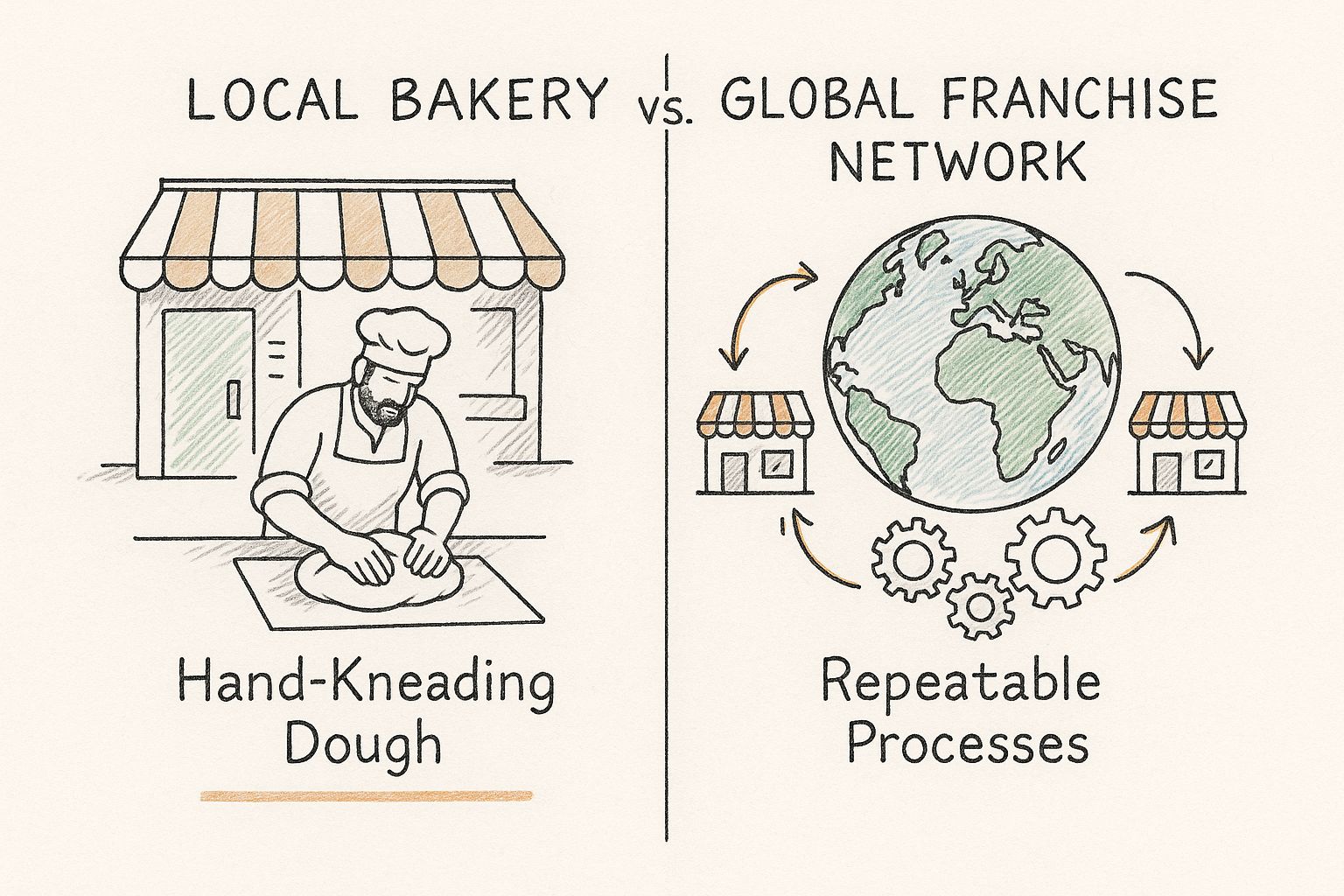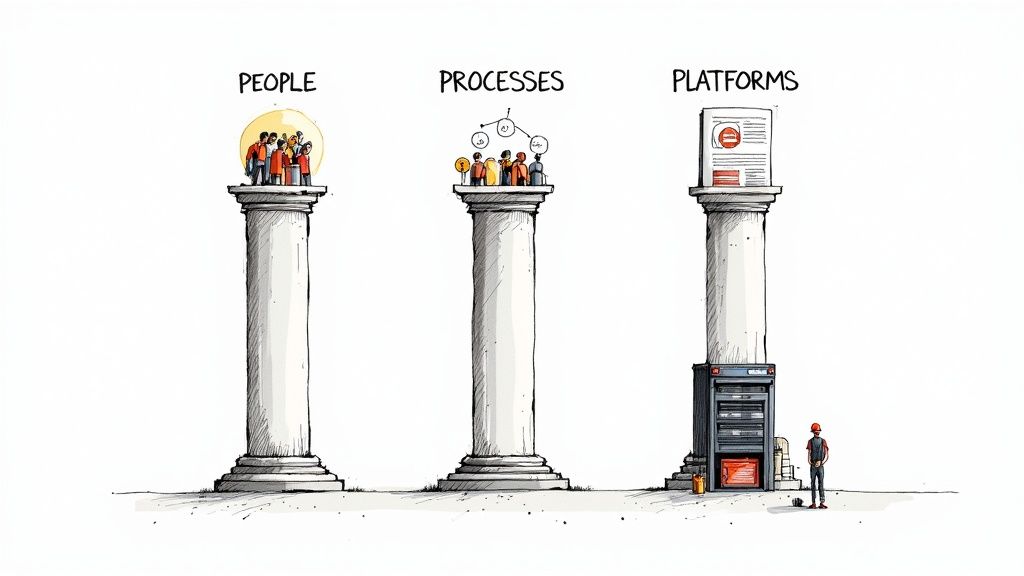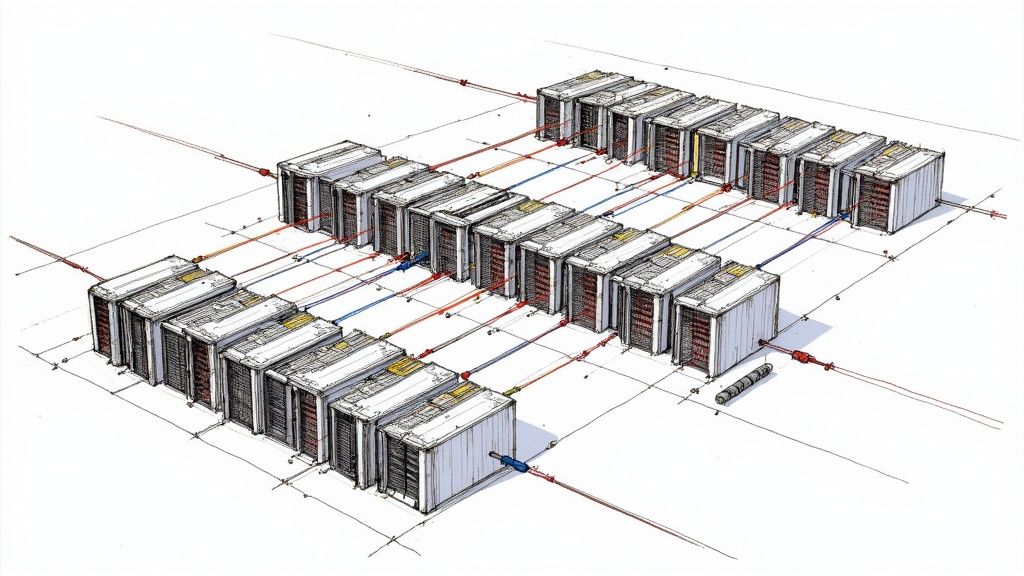October 17, 2025

So, what does it actually mean to "scale with systems"?
At its core, it's about building a business that can grow without you having to be in the weeds 24/7. It means creating repeatable processes, smart workflows, and using the right tech to build a sustainable growth engine. It’s the classic shift from just working harder to actually working smarter.
Think about a fantastic local bakery. The baker is incredibly talented, but to make more bread, she just has to work more hours. That’s the manual hustle—growth is directly tied to her personal effort.
Now, imagine a national bakery chain. It doesn't succeed because one person is working around the clock. It thrives because of standardized recipes, clearly defined roles for every employee, efficient supply chains, and consistent marketing plans. That, right there, is scaling with systems.
The whole idea is to move away from constantly putting out fires and making it up as you go. When your growth hinges on a few key people pulling all-nighters, you’ve got a problem. It's not sustainable, and it has a hard ceiling. But when your growth is built on solid, well-designed systems, it becomes predictable, strong, and can keep going and going.
This infographic breaks down the difference between these two mindsets perfectly.

As you can see, systemic growth is about building an interconnected machine where all the parts work together. Manual scaling, on the other hand, keeps everything siloed and dependent on individual heroics.
Let's get practical. What is a "business system"? Simply put, it's any documented process that gives you a consistent result without needing constant oversight or reinvention from the top. These can touch every single part of your business.
A business system is a documented, repeatable set of steps that allows your team to achieve a specific goal efficiently and consistently, turning chaotic tasks into predictable outcomes.
For example, a great first step is often tackling repetitive tasks. Implementing tools for social media automation can schedule posts and manage engagement, freeing up hours every week for more strategic thinking.
Other everyday examples include:
These systems are the blueprints that make your business run smoothly. They ensure critical tasks get done the right way, every time, no matter who is doing them. This consistency is the bedrock of a strong brand and a trustworthy customer experience.
To give you a clearer picture, let's break down the two approaches side-by-side.
This table offers a quick comparison, highlighting the fundamental differences between growing through sheer effort and growing through structured systems.
Seeing them laid out like this makes the choice pretty clear. While the initial hustle is necessary, the goal is always to build a blueprint for long-term success.
Ultimately, well-defined systems are also essential for great cross-departmental collaboration. When everyone understands their role within the larger machine, you replace guesswork with a clear roadmap, setting the stage for growth that can truly last.
When we talk about scaling with systems, it’s easy to think it’s all about software. But that’s only one piece of the puzzle. A truly scalable business is built on a solid foundation, and that foundation rests on three core pillars: People, Processes, and Platforms. Think of it like a three-legged stool—if one leg is wobbly, the whole thing comes crashing down.

These pillars work together, creating a framework you can use to see where your own business is strong and where it needs work. By shoring up each one, you’re building an organization that’s genuinely ready for its next big leap.
You can’t grow without a great team. That's a given. But a great team running on chaos and gut feelings can't scale. The People pillar is all about empowering your team to work with autonomy and purpose.
It starts by moving beyond vague job titles to define crystal-clear roles and responsibilities. When everyone knows exactly what they own—from lead generation to customer support—decisions happen faster and with way more confidence. Back this up with solid training that teaches them how to master the system, not just how to rely on the founder or a single star player. The real goal here is to build a culture of trust where people are equipped and empowered to run with their roles.
Processes are the secret sauce that turns frantic, repetitive tasks into smooth, predictable outcomes. They are the operational blueprint for your business. Without them, you’re just reinventing the wheel every single day, which is a recipe for burnout and inconsistent results.
Building solid processes boils down to a few key activities:
A well-defined process ensures quality is built-in, not bolted on. It’s how you make sure customer number 1,000 gets the same fantastic experience as customer number one.
Finally, we get to the tech. Platforms are the tools that glue your people and processes together, giving you the leverage to execute everything at scale. They're the force multipliers.
This is where you automate the tedious stuff, get real data to make smart decisions, and keep everyone on the same page. For example, a community platform like GroupOS can systematize everything from member onboarding to event management, getting you out of spreadsheet hell. A good CRM automates sales follow-ups, and a project management tool like Asana or Trello keeps projects on track.
Strong platforms are essential for creating the predictable outcomes needed for successful recurring revenue business models. They slash human error and, most importantly, free up your talented team to focus on the creative, high-impact work that actually moves the needle.
To see what scaling with systems looks like in the real world, let's zoom out from individual companies and look at something massive: the global shift to renewable energy. This transition isn’t just about putting up more solar panels or wind turbines one at a time. It’s a powerful story of how an entire interconnected system works together to create exponential change.
Think about it. A single solar panel on a roof is a nice gesture, but it won’t move the needle on a global scale. But what happens when you combine that with technological breakthroughs, smart economic incentives, standardized manufacturing, and supportive government policies? You get a flywheel effect—a self-reinforcing cycle of growth.
That’s systemic scaling on a planetary level.
The incredible growth of clean energy is a perfect lesson in how different systemic pillars can reinforce one another. It was never just one thing that made the difference. It was the combination of several key drivers all pushing in the same direction.
Here’s what that looked like:
None of these happened in a vacuum. Better technology made renewables cheaper, which encouraged governments to create supportive policies. Those policies then sparked more manufacturing and bigger investments in infrastructure. It's a web of interconnected parts, and that’s the essence of a powerful, scalable system.
This systems-based approach has pushed the clean energy transition past a critical tipping point. The global Energy Transition Index (ETI) recently improved by 1.1%, which is more than double the average increase we've seen in recent years.
The economics are now undeniable. Renewables like solar are, on average, 41% cheaper than fossil fuels. This advantage is fueling explosive growth, with clean energy now accounting for a staggering 92.5% of all new electricity capacity added worldwide. You can learn more about these global energy shifts and what they mean for the future.
This isn't just incremental growth. It's the complete restructuring of a century-old industry, and it was only possible because people started thinking in terms of integrated systems, not isolated parts.
The same principles apply to your business. Just as the energy sector uses interconnected systems to drive global change, you can build your own systems for operations, marketing, and community management. Tools like GroupOS help organizations create that predictable, scalable engine for growth, turning ambitious goals into real-world results.
If you want to see the principle of scaling with systems in action, look no further than the digital backbone of our economy: the data center. The insatiable demand for computing power, fueled by AI and the digital shift in nearly every industry, has completely changed the game. The old way of doing things—just cramming more servers into a room—is a brute-force tactic that simply doesn't work anymore. It's wildly unsustainable.

Today, the focus is on designing entire data center campuses as single, intelligent systems. This is systemic scaling made physical, where the architecture itself is the system. It’s a move away from thinking about individual servers and toward creating a cohesive environment built for massive growth, power efficiency, and easy expansion.
This is the only way to manage the mind-boggling complexity and cost of modern digital infrastructure.
The sheer power needed for new AI models has forced a ground-up rethinking of data center design. Modern facilities are now engineered from day one to handle huge power loads and incredibly dense clusters of computers.
This shift from isolated racks to interconnected ecosystems involves a few key systemic changes:
This industry is growing at a pace that is pushing the limits of traditional construction and design. In fact, spending on data center infrastructure is expected to blow past $1.7 trillion by 2030. Hyperscalers alone are projected to spend $300 billion in a single year. Power needs are jumping from tens of megawatts to nearly a gigawatt per campus—a leap that is impossible without smarter, systemic designs. You can find a great breakdown of these smarter data center design trends in this analysis from McKinsey.
The modern data center is more than just a building full of computers; it is a meticulously engineered system where every component—from the concrete foundation to the cooling pipes—is designed for scalable performance.
Thinking about infrastructure as one big, holistic system has huge implications. For example, all that hardware houses unimaginable amounts of data that need to be managed effectively. If you're curious about that side of things, our guide on database migration best practices offers a look into what it takes to handle data at this scale.
Scaling with systems isn't just about moving faster or doing more; it's about building a business that can withstand a punch. When you grow without putting safeguards in place, the very connections that make your business work can become your biggest liability.
What looks like a strength—a tightly woven network where every part talks to every other part—can quickly become a massive single point of failure. A small hiccup in one corner can set off a domino effect, grinding your entire operation to a halt.
Think about how this plays out on a global scale. The world's economic and political systems are hyper-connected, with a few major hubs—like the U.S. and China in global trade—acting as central nodes. This setup is incredibly efficient in good times, but it also creates enormous systemic risk. A shock to one of those hubs can send tidal waves across the entire network, threatening to break it apart.
Imagine a spiderweb. It’s a marvel of engineering, incredibly strong when pressure is spread out. But what happens if you snap the main anchor threads? The whole thing falls apart.
Too many businesses scale exactly like this, often without even realizing it. They become completely dependent on a single software platform, a key supplier, or even a handful of "irreplaceable" employees.
This creates a dangerously fragile operation. If your entire sales process runs through one CRM and that service has a massive outage, your revenue pipeline literally shuts down. Scaling the right way means building in backups and diversifying your dependencies to avoid these kinds of disasters.
The goal of scaling with systems isn't just to build a bigger machine. It's to build a smarter, tougher one. Resilience is the feature that makes sure your growth is sustainable, not just a short-term spike before an inevitable crash.
In a brittle, non-resilient system, small problems never stay small. A single delayed shipment from one supplier can shut down your entire production line. One buggy software update can corrupt essential data, destroying customer trust and creating a support team nightmare.
When you don't have backup plans and diversified resources, you're always playing defense, constantly reacting to the latest fire.
To build true resilience, you have to start asking "what if?" at every step of the process:
Thinking this way isn't about being pessimistic; it's just smart strategic planning. By anticipating where things might break, you can design systems that absorb shocks instead of magnifying them. This foresight is what keeps customers happy and loyal. After all, a resilient system prevents the exact kind of service interruptions that make people leave. Building in these safeguards is one of the most direct ways to reduce customer churn rates and protect the growth you’ve worked so hard to achieve.
Making the move to a systems-first mindset is a big deal, and it’s natural to have questions. Let's tackle some of the most common hurdles and concerns business leaders run into when they first start building systems to scale.
The best place to start is with your biggest headache. Seriously. Don't try to boil the ocean and systematize your entire business at once—that’s a fast track to burnout.
Instead, find the one thing that’s causing the most friction. What's the biggest bottleneck? What's the most repetitive, mind-numbing task? Is it onboarding new clients? Chasing down invoices? Creating social media content?
Once you’ve identified it, just write down how you do it right now. Don't worry if it's messy. Then, you can start polishing it. Talk to the people who actually do the work, get their input, and refine the steps into a simple Standard Operating Procedure (SOP). The idea is to start small, score an early win, and build momentum from there.
This is the big one. Team buy-in is everything. If your people see new processes as just more red tape designed to micromanage them, they’ll fight you every step of the way. The trick is to frame systems as tools that help them win.
The best way to do that? Involve them from the very beginning. Ask them what’s broken and what would make their jobs easier. When you introduce a new system, explain the why behind it. Show them how it will get rid of tedious tasks, cut down on mistakes, and give them more time to focus on the creative, high-impact work they were hired to do.
"A system is only as good as the people who use it. When your team views a process as a way to win, they won't just adopt it; they'll champion it."
Invest in good training, be patient while everyone gets up to speed, and make a big deal out of the first few successes. Once your team sees firsthand that a system makes their work-life better, they’ll become its biggest fans.
Not at all. That’s a huge misconception. In fact, you could argue systems are even more important for small businesses and startups. Putting simple, smart systems in place early on is what prevents the chaos that so often derails rapid growth. It builds a strong foundation that can handle more weight as you expand.
For a small business, a "system" doesn't have to be some complex software platform. It can be as straightforward as:
These aren't complicated, but they’re incredibly powerful. They create consistency and professionalism, and most importantly, they stop the founder from being the bottleneck for every single decision. That right there is the key to truly scaling a small business.
This is a great question, and it gets to the heart of what makes a system smart versus rigid. A system's job is to create a reliable framework, not a creative straitjacket. The best ones are designed to be flexible, with feedback loops built right in.
Make a habit of reviewing your core processes regularly—maybe once a quarter. Actively encourage your team to poke holes in them and suggest improvements. Give them a way to flag when a process feels clunky or outdated. A good system should define the what (the high-quality outcome you’re aiming for) and offer a proven path for the how, but it should always leave room for smart people to use their judgment.
Ultimately, systems are there to handle the predictable stuff with near-perfect efficiency. This frees up your team's most valuable asset—their brainpower—to focus on the unpredictable challenges and exciting opportunities where real innovation happens.
GroupOS gives you an all-in-one platform to systematize how you run your community. Handle everything from member onboarding and event ticketing to content delivery and engagement tracking. Ditch the chaotic spreadsheets and disconnected apps for a single, scalable solution. Start your free trial today.


